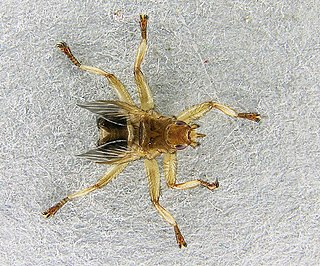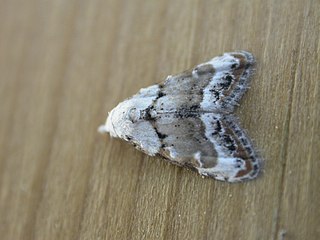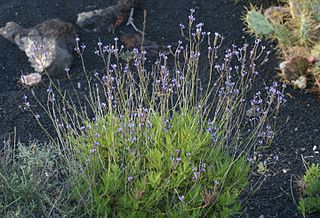
Lavandula is a genus of 47 known species of perennial flowering plants in the mints family, Lamiaceae. It is native to the Old World, primarily found across the drier, warmer regions of mainland Eurasia, with an affinity for maritime breezes.

Hippoboscidae, the louse flies or keds, are obligate parasites of mammals and birds. In this family, the winged species can fly at least reasonably well, though others with vestigial or no wings are flightless and highly apomorphic. As usual in their superfamily Hippoboscoidea, most of the larval development takes place within the mother's body, and pupation occurs almost immediately.

Nola subchlamydula is a moth of the family Nolidae. It is found in North Africa and Southern and South-Eastern Europe.

The Devonshire wainscot is a species of moth of the family Noctuidae. It is found in southern Europe, North Africa, Turkey, Israel, Lebanon.

Bystropogon is a genus of evergreen shrubs in the family Lamiaceae. It is native to the Canary Islands and Madeira in the eastern Atlantic Ocean. Allied to the Origanum and Thymus, the genus is characterized by tiny flowers in much-branched clusters, with plume-like sepals that elongate at the fruiting stage, giving the whole tip of each branch a fuzzy appearance. Stems are square in cross-section and leaves, arranged in opposite pairs, are aromatic when crushed.
Vulcaniella grabowiella is a moth of the family Cosmopterigidae. It is found from the Iberian Peninsula to Asia Minor.
Trifurcula sanctaecrucis is a moth of the family Nepticulidae. It is endemic to the Canary Islands.
Trifurcula stoechadella is a moth of the family Nepticulidae. It is found in the western Mediterranean region, from France and the Iberian Peninsula to Corsica and Italy.

Cacyreus virilis, the eastern bush blue, mocker bronze or mocker blue, is a butterfly of the family Lycaenidae. It is found from South Africa to Zimbabwe, through central and eastern Africa to south-western Arabia.
Merrifieldia malacodactylus is a moth of the family Pterophoridae. It is known from Central Asia, Yemen, Mediterranean Europe, Tunisia, Morocco, Anatolia, Syria, Iran, Afghanistan, Iraq, Lebanon, the Palestinian Territories and Russia.
Coleophora struella is a moth of the family Coleophoridae. It is found in France and on the Iberian Peninsula.

Merrifieldia chordodactylus is a moth of the family Pterophoridae. It is found on the Canary Islands and in Spain. It has also been recorded from Algeria and Morocco.
Stephensia abbreviatella is a moth of the family Elachistidae. It is found in France, Germany, Poland, the Czech Republic, Slovakia, Austria, Romania and Turkey.

Stephensia brunnichella is a moth of the family Elachistidae found in Europe and east into the Palearctic.
Stephensia calpella is a moth of the family Elachistidae. It is found in Spain and North Africa.
Stephensia staudingeri is a moth of the family Elachistidae. It is found on the island of Rhodes in Greece.

Apaidia mesogona is a moth of the family Erebidae first described by Jean Baptiste Godart in 1824. It is found in Western Europe, Sardinia, Corsica and North Africa.
Stephensia cunilae is a moth of the family Elachistidae. It is found in the United States, where it has been recorded from Ohio, Kentucky and Indiana.

Lavandula buchii is a species of flowering plant in the family Lamiaceae, endemic to Tenerife in the Canary Islands. It was first described by Philip Barker-Webb and Sabin Berthelot, in a part of an 1844–1850 publication that has been dated to 1844.

Lavandula canariensis is a species of flowering plant in the family Lamiaceae, native to the Canary Islands. It was first described by Philip Miller in 1768.










